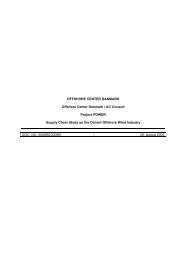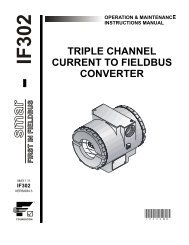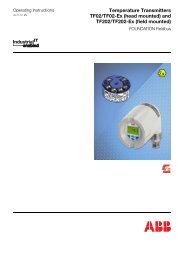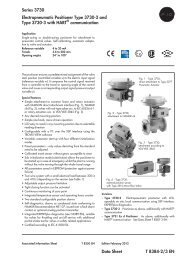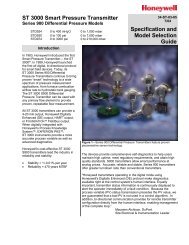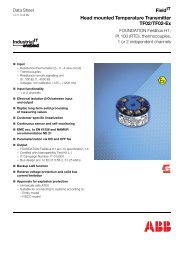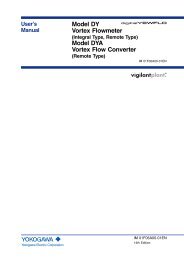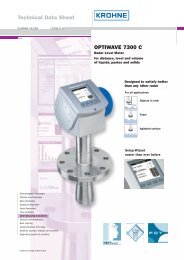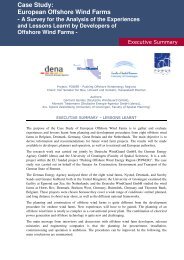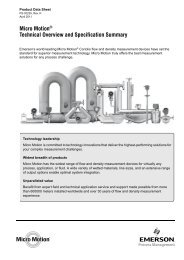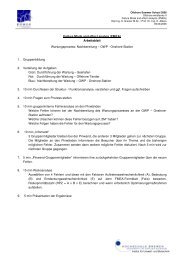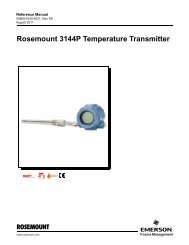[MI 019-120] I/A Series Mass Flowtubes Models CFS20 ... - Invensys
[MI 019-120] I/A Series Mass Flowtubes Models CFS20 ... - Invensys
[MI 019-120] I/A Series Mass Flowtubes Models CFS20 ... - Invensys
You also want an ePaper? Increase the reach of your titles
YUMPU automatically turns print PDFs into web optimized ePapers that Google loves.
Instruction<strong>MI</strong> <strong>019</strong>-<strong>120</strong>June 2011I/A <strong>Series</strong> ® <strong>Mass</strong> <strong>Flowtubes</strong><strong>Models</strong> CFS10 and <strong>CFS20</strong>Installation, Startup, Troubleshooting and Maintenance
<strong>MI</strong> <strong>019</strong>-<strong>120</strong> – June 2011
ContentsFigures.....................................................................................................................................Tables....................................................................................................................................vvii1. Introduction...................................................................................................................... 1General Description .................................................................................................................. 1Reference Documents ............................................................................................................... 1Standard Specifications ............................................................................................................. 3<strong>Mass</strong> Flow Rate Range ......................................................................................................... 3Process Fluid Density Ranges ............................................................................................... 3Approximate <strong>Mass</strong> ................................................................................................................ 4Flowtube Internal Fluid Volume .......................................................................................... 4Flowtube Coil Resistances .................................................................................................... 5Maximum Process Pressure .................................................................................................. 5Ambient Temperature Limits ............................................................................................... 6Process Fluid Temperature Range ........................................................................................ 6Mechanical Vibration ........................................................................................................... 6Product Safety Specifications ..................................................................................................... 72. Installation ...................................................................................................................... 11Flowtube Identification ........................................................................................................... 11Moving the Flowtube .............................................................................................................. 11Mounting Considerations ....................................................................................................... 12Mounting Procedure ............................................................................................................... 13Code A and B, Threaded End Connections ........................................................................ 16Code C, D, E, F, and J, Flanged End Connections ............................................................ 16Code P, Quick Disconnect End Connection ...................................................................... 17Code N, DIN Coupling End Connection .......................................................................... 173. Wiring............................................................................................................................. 19Cover Locks ............................................................................................................................ 19Junction Box ........................................................................................................................... 21Junction Box Extension ........................................................................................................... 21Signal Cable Preparation ......................................................................................................... 22Flowtube End ..................................................................................................................... 22Transmitter End (Customer Supplied Cable) ..................................................................... 23Flowtube Wiring ..................................................................................................................... 234. Startup ............................................................................................................................ 25iii
<strong>MI</strong> <strong>019</strong>-<strong>120</strong> – June 2011 ContentsSizing Your Flowtube and Determining Pressure Loss ............................................................. 25Filling the Flowtube ................................................................................................................ 25Zeroing ................................................................................................................................... 255. Troubleshooting.............................................................................................................. 27RTD Res Low or RTD Res High ............................................................................................ 276. Maintenance.................................................................................................................... 29Sanitary End Connection Couplings ....................................................................................... 29Cleaning the Flowtube ............................................................................................................ 29Flowtube Repair ...................................................................................................................... 29Meter Verification ................................................................................................................... 30Index .................................................................................................................................... 31iv
Figures1 Data Plate Location and Flowtube Identification ......................................................... 112 Support Required when Moving a Flowtube ................................................................ 123 Flowtube Mounting with Flanged End Connections - Horizontal Pipeline .................. 144 Flowtube Mounting with Threaded or Sanitary End Connections - Vertical Pipeline .. 145 Flowtube Mounting with Flanged End Connections - Vertical Pipeline ....................... 156 3 mm (1/8-inch) Flowtube Mounting .......................................................................... 157 Recommended Pipeline Supports ................................................................................. 168 Code A and B, Threaded End Connections ................................................................. 169 Code C, D, E, F, and J, Flanged End Connections ...................................................... 1710 Code P, Quick Disconnect End Connection ................................................................ 1711 Code N, DIN Coupling End Connection .................................................................... 1812 CFT50 Cover Locks ..................................................................................................... 1913 CFT51 Cover Locks ..................................................................................................... 2014 Flowtube Junction Box Cover Locks ............................................................................ 2015 Junction Box Extension ................................................................................................ 2216 Terminal Box Wiring Color Orientation ...................................................................... 2417 Resistance between Flowtube WiresConnected to Transmitter Terminals 1, 2, 3, and 4 ..................................................... 27v
<strong>MI</strong> <strong>019</strong>-<strong>120</strong> – June 2011 Figuresvi
Tables1 Reference Documents .................................................................................................. 12 <strong>Mass</strong> Flow Rate Range ................................................................................................. 33 Approximate Flowtube <strong>Mass</strong> ........................................................................................ 44 Flowtube Internal Volume ........................................................................................... 45 Flowtube Nominal Coil Resistances (a) ........................................................................ 56 End Connection Process Temperature/Pressure Limits (a) ........................................... 57 Flowtube Process Temperature/Pressure LimitsThreaded End Connections (a) .................................................................................... 68 Electrical Safety Specification (Applies to tubes used with CFT50 only) ...................... 79 Electrical Safety Specification (Applies to tubes used with CFT51 only) ...................... 710 Process Temperature Range for Electrical Safety Design Codes MMM, LLL, FBB, CDA,CNA, FNA, FDA, ADA, ANA, EDA, ENA ................................................................ 9vii
<strong>MI</strong> <strong>019</strong>-<strong>120</strong> – June 2011 Tablesviii
1. IntroductionGeneral DescriptionThe Model <strong>CFS20</strong> is a dual path mass flowtube that uses two parallel-connected, large-bore tubes.Fluid entering the flowtube is channeled through a rigid center body via two parallel loops backinto the outlet side of the rigid center body.The Model CFS10 is a single path mass flowtube that uses two serial-connected, large bore tubeloops positioned side by side. Fluid entering the flowtube is channeled first through one loop,through a rigid center body, and then through the second loop.Electromagnetic drivers bridge both loops at opposite extremities, equidistant from the center.Electromechanical sensors are used for Coriolis force measurement. Each sensor bridges bothloops and is positioned adjacent to a driver.The CFT50 or CFT51 <strong>Mass</strong> Flow Transmitter is wired to the Flowtube and provides analternating current to each driver. These currents are 180 out of phase so that as the driversalternately expand and contract, the pairs of tube ends alternately move away from each other andthen draw closer to each other. The result is that each tube effectively oscillates about its midpoint.The movement of the tube acts on the flowing fluid within the tube, so that a Coriolis force isgenerated normal to the flow path. This Coriolis force acts upon the tubes and consequently thesensors to provide a signal whose amplitude with respect to the drive signal is proportional to theprocess fluid mass flow rate.The density of the process fluid can also be measured because the natural driving frequency of theparallel flowtube is dependent upon the density of the fluid in the flowtube.Temperature measurement is achieved by an internally positioned Resistance TemperatureDetector (RTD).Reference DocumentsThis instruction covers the installation and maintenance of the CFS10 and <strong>CFS20</strong> <strong>Mass</strong><strong>Flowtubes</strong>. Refer to the list below for other supporting documents.Table 1. Reference DocumentsDocument No.Document DescriptionDimensional PrintsDP <strong>019</strong>-182 CFS10 Style B Flowtube Dimensions (1/4 through 2 inch)DP <strong>019</strong>-183 <strong>CFS20</strong> Style B Flowtube Dimensions (1-1/2 and 3 inch)DP <strong>019</strong>-365 CFS10 Style B Flowtube Dimensions (1/8 inch)DP <strong>019</strong>-366 CFS10 Style B Flowtube Dimensions (1/8 inch)DP <strong>019</strong>-<strong>120</strong> Dimensional Print for Single Measurement Configuration1
<strong>MI</strong> <strong>019</strong>-<strong>120</strong> – June 20111. IntroductionTable 1. Reference Documents (Continued)Document No.Instructions<strong>MI</strong> <strong>019</strong>-132<strong>MI</strong> <strong>019</strong>-133<strong>MI</strong> <strong>019</strong>-179<strong>MI</strong> <strong>019</strong>-140<strong>MI</strong> <strong>019</strong>-141Parts ListsPL 008-704PL 008-733PL 008-735PL 008-752Document DescriptionCFT50 Transmitter Installation, Startup, Configuration, and MaintenanceCFT50 Safety Connection Diagrams (FM, CSA)Instruction – Flow Products Safety Information (available only on websitewww.foxboro.com/instrumentation/tools/safety/flow)I/A <strong>Series</strong> ® Digital Coriolis <strong>Mass</strong> Flow Transmitter With HART andMODBUS Communication Protocols Model CFT51I/A <strong>Series</strong> ® Digital Coriolis <strong>Mass</strong> Flow Transmitter Model CFT51 SafetyConnection Diagrams (FM, CSA)CFT50 Transmitter Parts ListCFS10 Style B <strong>Flowtubes</strong>, Sanitary/General, Parts List<strong>CFS20</strong> Style B <strong>Flowtubes</strong>, Sanitary/General, Parts ListI/A <strong>Series</strong> ® <strong>Mass</strong> Flow and Density Meters Model CFT51 Digital Coriolis<strong>Mass</strong> Flow Transmitter with HART or Modbus Communication Protocol2
1. Introduction <strong>MI</strong> <strong>019</strong>-<strong>120</strong> – June 2011Standard Specifications<strong>Mass</strong> Flow Rate RangeThe mass flow rate range is dependent on the flowtube size. Refer to Table 2 for the mass flow raterange for each flowtube size.Table 2. <strong>Mass</strong> Flow Rate RangeFlowtubeFlowtube Size Nominal <strong>Mass</strong> Flow Rate Extended Upper Range (a)Model in mm kg/min lb/min kg/min lb/minCFS10 1/8 3 0.03 to 3.2 0.07 to 7 7 151/4 6 0.09 to 9 0.2 to 20 22 481/2 15 0.4 to 40 0.9 to 90 73 1603/4 20 0.9 to 90 2 to 200 119 2611 25 1.8 to 180 4 to 400 244 5361-1/2 40 4 to 400 9 to 900 607 13352 50 7 to 700 15 to 1500 1023 2250<strong>CFS20</strong> 1-1/2 40 4 to 400 9 to 900 485 10703 80 18 to 1815 40 to 4000 2040 4500Process Fluid Density Ranges<strong>Mass</strong> Flow Rate Ranges(a)The extended upper ranges shown above are based on a process fluid specific gravity of 0.8 and a temperature of212°F (100°C). To find the extended upper range at other specific gravities and temperatures, contact <strong>Invensys</strong> .Process fluid density ranges of 200 to 3000 kg/m 3 (12.5 to 187 lb/ft 3 ), or specific gravity rangeof 0.2 to 3. Note that a specific gravity of 1 corresponds to a fluid density of 1000 kg/m 3(62.4 lb/ft 3 ).3
<strong>MI</strong> <strong>019</strong>-<strong>120</strong> – June 20111. IntroductionApproximate <strong>Mass</strong>Flowtube mass is dependent on flowtube size and end connections used. Refer to Table 3.Table 3. Approximate Flowtube <strong>Mass</strong>FlowtubeModelCFS10<strong>CFS20</strong>(a) Not available.Flowtube SizemminWith ANSI Class150 Flanged EndsFlowtube Internal Fluid VolumeWith ThreadedEnds3 1/8 (a) 6.3 kg(13.9 lb)6 1/4 9.6 kg8.8 kg(21 lb)(19.4 lb)15 1/2 11.5 kg10.4 kg(25.5 lb)(22.9 lb)20 3/4 18.5 kg16.7 kg(40.5 lb)(36.8 lb)25 1 22.5 kg(a)(49.5 lb)40 1-1/2 53.4 kg(a)(118 lb)50 2 77.6 kg(a)(171 lb)40 1-1/2 24 kg(a)(53 lb)80 3 111 kg(a)(244 lb)With SanitaryEndsFlowtube internal fluid volume is dependent on the flowtube size and the end connections used.Refer to Table 4.Table 4. Flowtube Internal VolumeFlowtubeModelCFS10<strong>CFS20</strong>(a) Not available.(a)8.8 kg(19.4 lb)10.4 kg(22.9 lb)16.7 kg(36.8 lb)20.3 kg(44.8 lb)49.9 kg(110 lb)71.2 kg(157 lb)(a)99.3 kg(219 lb)Nominal FlowtubeFlowtube Internal Fluid VolumeSize With Flanged/Threaded Ends With Sanitary Endsmm in cm 3 in 3 cm 3 in 33615202540501/81/41/23/411-1/22186732110131591463879341.14206297283484(a)743521111163048188227(a)521689929450240 1-1/2 2621 160 (a) (a)80 3 10,015 611 9632 5884
1. Introduction <strong>MI</strong> <strong>019</strong>-<strong>120</strong> – June 2011Flowtube Coil ResistancesMaximum Process PressureTable 5. Flowtube Nominal Coil Resistances (a)Flowtube Model Flowtube Line Size Driver Resistance Sensor ResistanceCFS10<strong>CFS20</strong>(a)At room temperature.3 mm (1/8 in) 12 2006 mm (1/4 in) 30 5015 mm (1/2 in) 12 1220 mm (3/4 in) 12 1225 mm (1 in) 25 1240 mm (1-1/2 in) 40 1250 mm (2 in) 40 1240 mm (1-1/2 in) 25 1280 mm (3 in) 40 12Maximum process pressure is dependent on the process temperature, flowtube size, and endconnections used. The following tables specify the maximum process pressure for either the typeof end connection (Table 6) or process temperature (Table 7). Interpolation is required for processtemperatures between those listed. Use the lesser of the pressures determined from these tables.Table 6. End Connection Process Temperature/Pressure Limits (a)ProcessEnd Connection Type Temp.ANSI ® Class 150 Flange 100°F200°F300°F356°FANSI Class 300 Flange 100°F200°F300°F356°FANSI Class 600 Flange 100°F200°F300°FBS 4504 (DIN) PN 10/16PN 25/40FlangeFlange to Mate with BS 4504(DIN), PN 100/2356°F40°C100°C150°C180°C40°C100°C150°C180°CMWP (b)316/316L ss Nickel Alloy275 psig240 psig215 psig208 psig720 psig620 psig560 psig540 psig1440 psig1240 psig1<strong>120</strong> psig1080 psig40.0 bar(c)34.2 bar(c)30.8 bar(c)29.3 bar(c)96 bar(c)82 bar(c)75 bar(c)72 bar(c)290 psig260 psig230 psig217 psig750 psig750 psig730 psig719 psig1500 psig1500 psig1455 psig1435 psig41.7 bar(c)37.1 bar(c)32.9 bar(c)30.6 bar(c)103 bar(c)103 bar(c)100 bar(c)98 bar(c)5
<strong>MI</strong> <strong>019</strong>-<strong>120</strong> – June 20111. IntroductionTable 6. End Connection Process Temperature/Pressure Limits (a) (Continued)ProcessMWP (b)End Connection Type Temp. 316/316L ss Nickel AlloyThreaded, NPT, ANSI B2.1 MWP limited by threaded end connection limits perTable 7.Sanitary (Tri-Clamp ® Ferrule Maximum working pressure is 10 bar at 25°Cand DIN 11851) (d) (145 psig at 77°F).(a)Linear interpolation is acceptable.(b)See Model Codes for flowtube configurations available with 316 ss, 316L ss, and Nickel alloy(equivalent to Hastelloy-C ® a ) end connections.(c)To obtain MPa values, divide bar value by 10.To obtain kPa values, multiply bar value by 100.(d)If higher MWPs are required, contact <strong>Invensys</strong>.a. Hastelloy is a registered trade mark of Haynes International Inc.Ambient Temperature Limits–40 and +85C (–40 and +185F)Process Fluid Temperature RangeSee Table 10.NominalFlowtube SizeMechanical VibrationTable 7. Flowtube Process Temperature/Pressure LimitsThreaded End Connections (a)ProcessTemperature10 m/s 2 (1 ‘g’) at 5 to 40 and 100 to 200 Hz.Maximum Working Pressure (MWP)316/316L ss Nickel Alloymm in °C °F bar (b) psig bar (b) psig3and615and201/8and1/41/2and3/44010015018040100150180100200300356100200300356(a) Linear interpolation is acceptable.(b)To obtain MPa value, divide bar value by 10.To obtain kPa value, multiply bar value by 100.2071741561481008578753000253022702144144012401<strong>120</strong>108021721721320710310310098315031503050301015001500145514356
1. Introduction <strong>MI</strong> <strong>019</strong>-<strong>120</strong> – June 2011Product Safety SpecificationsRefer to Table 8 for flowtube Electrical Safety Specifications. Wiring restrictions required tomaintain flowtube electrical safety specifications are provided in “Wiring” on page 19. Refer toappropriate transmitter instruction for transmitter electrical safety specification information.Table 8. Electrical Safety Specification (Applies to tubes used with CFT50 only)Testing Laboratory,Electricaland Area Classification Application Conditions (a) CodeType of Protection,Safety DesignATEX (KEMA) intrinsically safeII 2 G, EEx ib, IIB, Zone 1.ATEX (KEMA) nonsparkingII 3 G EEx nA II; Zone 2.CSA nonincendive for use inClass I, Division 2, Groups A, B,C, and D, hazardous locations.FM intrinsically safe apparatus forClass I, Division 1, Groups C andD, hazardous locations.FM nonincendive for use inClass I, Division 2, Groups A, B,C, and D hazardous locations.Agency approvals or certifications are not required.Connected to CFT50-......M or Q <strong>Mass</strong> FlowTransmitter.Connected to Model CFT50-......T <strong>Mass</strong> FlowTransmitter.Connected to CFT50-......L, P, or S <strong>Mass</strong> FlowTransmitter per <strong>MI</strong> <strong>019</strong>-133/<strong>MI</strong> <strong>019</strong>-141.Connected to CFT50-......K or N <strong>Mass</strong> FlowTransmitter per <strong>MI</strong> <strong>019</strong>-133/<strong>MI</strong> <strong>019</strong>-141.Connected to CFT50-......K, N, or R <strong>Mass</strong> FlowTransmitter per <strong>MI</strong> <strong>019</strong>-133/<strong>MI</strong> <strong>019</strong>-141.(a)Temperature Class is a function of process temperature. See Table 10.MMMLLLCNNFBBFNNZZZTable 9. Electrical Safety Specification (Applies to tubes used with CFT51 only)Testing Laboratory,Type of Protection, andArea ClassificationCSA/CSAus Division 1/Zone 0Intrinsically SafeCSA/CSAus Division 2/Zone 2Non-IncendiveFM Division 1/Zone 0 IntrinsicallySafeFM Division 2/Zone 2 Non-IncendiveATEX Intrinsic safe Ex ia/icApplication ConditionsConnected to CFT51 Electrical Safety CodeCDA and CNAConnected to CFT51 Electrical Safety CodeCDN and CNNConnected to CFT51 Electrical Safety CodeFDA and FNAConnected to CFT51 Electrical Safety CodeFDA and FNNConnected to CFT51 Electrical Safety CodeADA and ANAATEX Non Sparking Zone 2 Ex nA Connected to CFT51 Electrical Safety CodeADN and ANNElectricalSafety DesignCodeCAACCNFAAFFNAAAANN7
<strong>MI</strong> <strong>019</strong>-<strong>120</strong> – June 20111. IntroductionTable 9. Electrical Safety Specification (Applies to tubes used with CFT51 only)Testing Laboratory,Type of Protection, andArea ClassificationApplication ConditionsIECEx Intrinsic safe Ex ia/ic Connected to CFT51 Electrical Safety CodeEDA and ENAIECEx Non Sparking Zone 2 Ex nA Connected to CFT51 Electrical Safety CodeEDN and ENNAgency approvals or certifications not requiredElectricalSafety DesignCodeEAAENNZZZNOTEThese flowtubes have been designed to meet the electrical safety description listedin the table above. For detailed information or status of testing laboratoryapproval/certifications, contact <strong>Invensys</strong>.8
1. Introduction <strong>MI</strong> <strong>019</strong>-<strong>120</strong> – June 2011Table 10. Process Temperature Range for Electrical Safety Design Codes MMM, LLL, FBB, CDA,CNA, FNA, FDA, ADA, ANA, EDA, ENAProcess Temperature Range for Electrical Safety Design CodeFlowtubeModelCFS10CFS10<strong>CFS20</strong>FlowtubeSize Ambient TemperatureTempProcess Temperature Rangemm in °C °F Class °C °F3through2025through5040 and800.125through0.7501.000through2.0001.5 and3.0-40 to +60 (1) -40 to +140-40 to +60 (1) -40 to +140T2 -200 to +200 -328 to +392T3 -200 to +160 -328 to +320T4 -200 to +95 -328 to +203T5 -200 to +60 -328 to +140T6 -200 to +45 -328 to +113T2 -55 to +165 -67 to +329T3 -55 to +165 -67 to +329T4 -55 to +95 -67 to +203-40 to +60 (1) -40 to +140 T5 -55 to +60 -67 to +140T6 -55 to +45 -67 to +113FlowtubeModelCFS10and<strong>CFS20</strong>Process Temperature Range for Electrical Safety Design Code LLLFlowtubeSize Ambient TemperatureProcess Temperature RangeTempmm in °C °F Class °C °FAllFlowtubeSizes-40 to +85 -40 to +185 T3 -40 to +180 -40 to +356-40 to +85 -40 to +185 T4 -40 to +115 -40 to +239-40 to +80 -40 to +176 T5 -40 to +80 -40 to +176-40 to +65 -40 to +149 T6 -40 to +65 -40 to +149Process Temperature Range for Electrical Safety Design Code FDN, FNN, CDN, CNN, ADN, ANN,ENN, EDNFlowtubeModelCFS10and<strong>CFS20</strong>FlowtubeSize Ambient TemperatureTempProcess Temperature Rangemm in °C °F Class °C °F6 0.250-135 to +195 -211 to +38315 0.500 -200 to +195 -328 to +38320 0.750 -200 to +195 -328 to +38325 1.000 -40 to + 60 (1) -40 to +140 T5 -50 to +195 -58 to +38340 1.500 -50 to +195 -58 to +38350 2.000 -50 to +175 -58 to +34780 3.000 -50 to +175 -58 to +347(1) Ambient low temperature limit increases to -20°C/-4°F when using the CFT50 transmitter.9
<strong>MI</strong> <strong>019</strong>-<strong>120</strong> – June 20111. Introduction10
2. InstallationFlowtube IdentificationRMASS FLOWMETERMODEL NO . CFT51-ST.REF NO.ORIGININPUT SUPPLYINPUT POWERAMBIENT TEMP. - 40º C TO 60 º CCUST. DATACAUTION: CABLE ENTRIESASSEMBLED IN USAINVENSYS SYSTEMS INC.FOXBORO MA., USA 02035SEE SALES ORDERTYPE OF CONDUIT OPENINGSSTYLE “A” DESIGNATIONMODEL CODE PER SALES ORDERSERIAL NUMBERDATE CODE<strong>120</strong>/240 V ac 50/60 HzOR 36 V dc MAX20 VA MAXOR 1A, 15 W0344II 3 G Ex nA IIC T4 Gc Ta =(-40°C to +60°C)SIRA 10ATEX2290 XII 1 G Ex ia IIB T4 Ga Ta =(-40°C to +60°C)II 3 G Ex ic IIB T4 Gc Ta =(-40°C to +60°C)SIRA 10ATEX2290 XPERMANENTLY MARK ONE TYPE OF PROTECTION! ONCE CHOSEN, IT CAN NOT CHANGE, NOTFOLLOWING THESE INSTRUCTIONS WILLJEOPARDIZE EXPLOSION SAFETY.CONNECT ONLY TO CERTIFIEDCFT51-.........ADA, ADN, ANA OR ANN TRANS<strong>MI</strong>TTERS.SEE CERTIFICATE FOR TEMPERATURE AND ELECTRICAL DATA.WARNING: ENSURE AREA IS KNOWN TO BE NON-HAZARDOUSBEFORE REMOVING COVER.WARNING: TO PREVENT IGNITION OF FLAMMABLE ORCOMBUSTIBLE ATMOSPHERES, DISCONNECT POWER BEFORESERVICING.WARNING: EXPLOSION HAZARD - DO NOT DISCONNECTEQUIPMENT UNLESS POWER HAS BEEN TURNED OFF OR THEAREA IS KNOWN TO BE NON -HAZARDOUS.WARNING: EXPLOSION HAZARD - SUBSTITUTION OFCOMPONENTS MAY IMPAIR SUITABILITY FOR ZONE 2 ORINTRINSIC SAFETY.AGENCY PLATEFigure 1. Data Plate Location and Flowtube IdentificationNOTEThe MVV coefficient is applicable only for systems used with the CFT51.! CAUTIONBefore installing your flowtube, copy the following information from the flowtubedata plate (see Figure 1): MODEL, SENSOR IDENT, DENSC 1, DENSC 2,DENSC 3, DENSC 4, DENSC 5 (if provided), DENSC 6 (if provided), FLOW C1,FLOW C2, FLOW C3, FLOW C4 (not used with CFT50 or CFT51),NOM CAPACITY, TP COR S (if provided), and TP COR O (if provided). Thisinformation is required when programming the transmitter.Density and flow coefficients use an exponential format for the CFT50, CFT10/15, but thedensity and flow coefficients for the CFT51 use a decimal format.Moving the FlowtubeCare must be exercised when moving the flowtube to avoid personal injury and prevent damageto the flowtube and integral cable extending from flowtube. Refer to the followingrecommendations for proper handling and support of the flowtube. Before removing flowtube from shipping container, move the flowtube as close to theinstallation location as possible.11
<strong>MI</strong> <strong>019</strong>-<strong>120</strong> – June 20112. InstallationSmaller flowtubes can be removed from the shipping container and installed betweenthe upstream and downstream pipe connections by hand lifting and carrying.However, to avoid personal injury and/or damage to the flowtube, larger flowtubesmust be lifted and restrained as shown in Figure 2. Note that in addition to using theupstream and downstream connections, the flowtube must also be restrained at bothsides to prevent rotation as the flowtube is lifted.! CAUTIONDo not lift or support the flowtube by its junction box or cable.Mounting ConsiderationsFigure 2. Support Required when Moving a Flowtube The flowtube and cable should be mounted no closer than 3 m (10 ft) from anymotor, speed controller, large transformer, or power contactor. Standard practice is to mount the flowtube on a horizontal pipe as shown in Figures 3,4, and 6. For self-draining, or if the process fluid contains gas bubbles, the flowtubeshould be mounted on a vertical pipe as shown in Figures 5 and 6.NOTEPerformance and operation are not affected by the orientation of the flowtube,except that when vertical mounting is used, flow must be upward through theflowtube.When required by the process application, the flowtube can be heat traced orinsulated with a lightweight material.12
2. Installation <strong>MI</strong> <strong>019</strong>-<strong>120</strong> – June 2011! CAUTIONThe flowtube case must not be pierced. The interior is filled with an inert gaspressurized at 70 kPa (10.15 psia).! DANGERIf the process fluid is a gas at ambient conditions, but is in the liquid state due to linepressure, the flowtube must be enclosed in a containment unit. In the event of a breakin the flowtube, increasing pressure inside the flowtube case can cause the case toburst. Failure to comply with this warning could result in severe injury or death.Mounting ProcedureThe flowtube can be mounted horizontally or vertically as shown in Figures 3 through 6. Whenmounted vertically (as in self-draining applications), the direction of flow must be upward tominimize the incidence of trapped air. All of the following steps apply to both horizontal andvertical mounting.NOTEFor 3-A sanitary compliance, flowtube MUST be installed vertically.1. Determine the face-to-face distance between the flowtube end connections. Refer to“Reference Documents” on page 1 for Dimensional Prints.2. Fabricate the end connections to the pipe.3. Provide upstream and downstream flowline supports. Supports can extend from floor,ceiling, or wall, as convenient, but should not be firmly secured to the pipeline at thistime. Refer to Figure 7 for types of recommended pipeline supports. Note that “resttype” supports should not be used for flowtube sanitary connection types N and P.NOTE1. Each support must contact flowline as close to the junction of pipe and flowtubeenclosure as practically possible. For flowtubes with flanged end connections(Figure 3 and Figure 5), the distance between each support and the junctionmust not exceed 38 cm (15 inches).2. For sanitary flowtube end connections N and P, and if flowtube size is 15 mm(1/2 in) or greater, additional supports must be positioned between the flowtubeenclosure and the junction of flowtube and pipeline.3. All supports must provide a minimum of 25 mm (1 in) of axial length of surfacecontact.4. A filter is recommended on the smaller line sizes to minimize problems with dirtparticles introduced during installation.4. Move the flowtube into position between the flowline end connections. Arrow on theflowtube must be pointing in the direction of flow.5. Align the flowtube and flowline end connections. Secure the flowtube to the flowline.Various end connections are described on page 16 through page 18.13
<strong>MI</strong> <strong>019</strong>-<strong>120</strong> – June 20112. InstallationNOTE:DISTANCE BETWEENPIPE/FLOWTUBEJUNCTION AND SUPPORTMUST NOT EXCEED38 cm (15 in)Figure 3. Flowtube Mounting with Flanged End Connections - Horizontal PipelineFigure 4. Flowtube Mounting with Threaded or Sanitary End Connections - Vertical PipelineFor 3-A sanitary compliance, flowtube MUST be installed vertically.When installing a sanitary flowtube in a vertical pipeline, ensure that the pipeline supports arealso between the enclosure and end connection, as shown Figure 4.14
2. Installation <strong>MI</strong> <strong>019</strong>-<strong>120</strong> – June 2011NOTEHorizontal pipeline mounting is not recommended when self-draining is required,or when gas bubbles are present.SUPPORT(TYPICAL)MASS FLOWTUBE ENCLOSUREFLOWDIRECTION ARROWDISTANCE BETWEEN PIPE/FLOWTUBEJUNCTION AND SUPPORT MUSTNOT EXCEED 15 INCHES.Figure 5. Flowtube Mounting with Flanged End Connections - Vertical PipelinePIPELINESUPPORTSFLOW DIRECTIONARROWFLOW DIRECTION ARROWPIPELINESUPPORTSHORIZONTAL MOUNTING1/4 NPTTHREADED ENDCONNECTION1/4 NPTTHREADED ENDCONNECTIONVERTICAL MOUNTINGFigure 6. 3 mm (1/8-inch) Flowtube Mounting! CAUTIONFlowtube CFS10-02 (1/8-inch) must be mounted with pipeline supports inside ofthreaded ends, as shown in Figure 6.15
<strong>MI</strong> <strong>019</strong>-<strong>120</strong> – June 20112. InstallationFigure 7. Recommended Pipeline SupportsCode A and B, Threaded End Connections1. Apply process compatible thread sealant to the threaded flowtube end connection.2. Secure the threaded pipe adapter to the flowtube threaded end connection.3. Secure the pipeline end of adapter to the pipeline.4. Tighten the hardware to secure the flowline to the supports.Figure 8. Code A and B, Threaded End ConnectionsCode C, D, E, F, and J, Flanged End ConnectionsRefer to current pipe flange and fitting standards for proper gasket dimensions.1. Insert the lower mounting bolts (2 for 4-hole flanges, or 4 for 8-hole flanges).2. Position the gasket between the flanges.3. Insert the remaining mounting bolts.4. Add the washers and nuts to all bolts and hand tighten only.5. Secure the meter by tightening the nuts in uniform steps, working from nut toopposite nut.6. Tighten the hardware to secure the pipeline to the supports.16
2. Installation <strong>MI</strong> <strong>019</strong>-<strong>120</strong> – June 2011Figure 9. Code C, D, E, F, and J, Flanged End ConnectionsCode P, Quick Disconnect End Connection1. Insert the seal into each flowtube end connection.2. Make full face contact between the flowtube end connection and the pipeline endconnection.Figure 10. Code P, Quick Disconnect End Connection3. Position the clamp over the mating surfaces of the flowtube end connection and thepipeline end connection and press the clamp closed.4. Tighten the hardware to secure the flowtube and pipeline to the supports.Code N, DIN Coupling End Connection1. Insert the seal into the groove in each flowtube end connection.2. Bring the pipeline end connection into full contact with the flowtube end connectionand tighten the nut on the pipeline end connection securely.3. Tighten the hardware to secure the flowtube and flowline to the supports.17
<strong>MI</strong> <strong>019</strong>-<strong>120</strong> – June 20112. InstallationFigure 11. Code N, DIN Coupling End Connection18
3. WiringThe installation and wiring of the flowtube must conform to local code requirements. If theflowtube is classified intrinsically safe (refer to model number), it also must conform to nationalstandards for installation of intrinsically safe equipment in potentially hazardous areas.! DANGERIf the flowtube is classified intrinsically safe, connect the ground (potential equalizing)terminals on the flowtube (refer to dimensional prints listed in Table 1) and thetransmitter (see <strong>MI</strong> <strong>019</strong>-132, <strong>MI</strong> <strong>019</strong>-133, <strong>MI</strong> <strong>019</strong>-140, and <strong>MI</strong> <strong>019</strong>-141) to thebuilding signal ground reference point with a dedicated wire of 12 AWG or larger.The total resistance of the ground path must not exceed one ohm. Note that this is inaddition to the transmitter ac power ground. The intrinsic safety of the flowtube andinterconnecting wiring is dependent on making this connection.Cover LocksThe following diagram illustrates the lock and seal mechanisms provided as part of the CFT50Custody Transfer NTEP (-T) and Tamperproof Sealing (-S) model code selections. Forinstructions on locking the CFT50, refer to <strong>MI</strong> <strong>019</strong>-132 (HART) or <strong>MI</strong> <strong>019</strong>-134 (Modbus).CFT50Housing Cover LockCFT50Junction Box Cover LockFigure 12. CFT50 Cover LocksThe following diagram illustrates the lock and seal mechanisms provided as part of the CFT51Custody Transfer NTEP (-T) and Tamperproof Sealing (-S) model code selections. Forinstructions on locking the CFT51, refer to <strong>MI</strong> <strong>019</strong>-140 (HART or Modbus).19
<strong>MI</strong> <strong>019</strong>-<strong>120</strong> – June 20113. WiringCFT51 HousingCover LockCFT51 Junction BoxCover LockFigure 13. CFT51 Cover LocksThe following diagram illustrates the lock and seal mechanisms provided as part of the CFSCustody Transfer NTEP (-T) and Tamperproof Sealing (-S) model code selections. To lock thecovers on the flowtube junction box, slide the seal wire through the holes in the three elongatedcover screws and crimp the seal.Figure 14. Flowtube Junction Box Cover Locks20
3. Wiring <strong>MI</strong> <strong>019</strong>-<strong>120</strong> – June 2011Junction BoxAn electrical junction box meeting NEMA 4X and IP54 requirements is mounted on eachflowtube. It is fitted with a 3/4 NPT female cable entrance. Contained within the junction boxare a pair of 6-position feedthrough type screw terminal blocks (properly spaced for intrinsicsafety) which are prewired to the flowtube. Signal cable is not supplied with the flowtube, butPVC insulated (Model KFS1) and FEP insulated (Model KFS2) cable in specific lengths from 6to 300 m (20 to 1000 ft) is available from <strong>Invensys</strong>. One end of the cable is prepared for directconnection to the transmitter. The PVC cable can be used for most applications within anambient temperature range of -20 to +80°C (-4 to +176°F). The FEP cable is suitable for ambienttemperatures from -40 to +85°C (-40 to +185°F). If cable other than that supplied by <strong>Invensys</strong> isinstalled, the use of individually shielded 6 twisted pair signal cable of 22 AWG or larger (Belden#8778) is recommended. The total cable length from transmitter to flowtube must not exceed300 m (1000 ft).! CAUTIONDo not route signal cable close to power cables or equipment that can produce a largemagnetic field.If conduit is to be used, install a watertight conduit connector and drip loop at the junction boxto prevent collection of condensate. If conduit is not used, a watertight cable grip is required.Teflon thread sealant on the connector threads is recommended to reduce the risk of galvaniccorrosion.If rigid conduit is used, the length extending from the conduit fitting must not exceed 0.3 m(12 in). This conduit must not be subjected to additional mechanical loading or attachment. Ifadditional protection is required, flexible armored sheathing is recommended.Junction Box ExtensionThe normal clearance between the rear of the junction box and the flowtube case is 0.5 inch(12.7 mm). To accommodate a steam jacket or case insulation, this distance can be increased to4.00 inches (101.6 mm). A kit for this purpose is available (Part No. G0117HZ) consisting of a3/4 NPT Schedule 40 stainless steel pipe coupling, 2-1/2 inch long nipple and thread sealant (seeFigure 15).! CAUTION<strong>Invensys</strong> does not recommend junction box extension without the addition of a steamjacket or case insulation.To promote heat dissipation at elevated operating temperatures, maintain a space of at least13 mm (0.5 inch) between the rear of the junction box and the case insulation or steam jacket.The procedure for installing a junction box extension follows:1. Remove the junction box cover.2. Loosen the terminal block wiring screws and disconnect the flowtube wiring. Ensurethat the wire pairs remain twisted to facilitate identification.21
<strong>MI</strong> <strong>019</strong>-<strong>120</strong> – June 20113. Wiring3. Unscrew and remove the junction box from the flowtube using a suitable tool (such asa length of pipe inserted in the conduit entrance). Remove all thread sealant residue.4. Apply sealant to all male threads.5. Insert the flowtube wiring through the coupling, nipple, and base of junction box andengage the threads.6. Tighten the assembly, locating the conduit entrance as desired.7. Reconnect the flowtube wiring to the appropriate terminals (see Figure 16) andtighten the screws.! CAUTIONNo bare wire should be visible at the terminals. Ensure that the wire insulation has notprevented electrical contact.8. Dress excess flowtube wire within the junction box as necessary.NIPPLECOUPLINGSignal Cable PreparationFigure 15. Junction Box ExtensionIf conduit is to be used, run the unprepared end of the cable through the conduit from thetransmitter.Flowtube End1. Cut the flowtube end of the cable to length and strip back the jacket approximately127 mm (4 in).2. Separate the twisted pair conductors from their wrappers, shields, and drain wires.The wire pairs should remain twisted for ease of identification.3. Trim the shields, wrappers, and drain wires back to the jacket interface.22
3. Wiring <strong>MI</strong> <strong>019</strong>-<strong>120</strong> – June 20114. Strip the ends of the conductors 6 mm (1/4 in).Transmitter End (Customer Supplied Cable)Follow Steps 1, 2, and 4 above. Trim shields and wrappers back to the jacket interface. Tightlytwist together (2 to 4 turns) the six individual twisted pair drain wires at a point close to the jacketinterface. Trim all but one drain wire close to the twist. Solder the twisted wire area, creating asingle drain wire. Appropriately insulate the drain wire and soldered connection to preventshorting. Refer to <strong>MI</strong> <strong>019</strong>-132 for CFT50 or <strong>MI</strong> <strong>019</strong>-140 for CFT51 wiring instructions.Flowtube Wiring1. Remove the junction box cover and insert the prepared cable end through either acable grip or conduit connector. Route the paired wires to the proper terminal block.To facilitate wire identification, ensure that the proper wire pairs remain twisted as theblack wires are not common.2. Insert the ends of the individual wires into the appropriate terminal block openings,carefully matching the wire color pairs of the cable to the wire color pairs of theflowtube (see Figure 16). Tighten the screws. No bare wire should be visible. Dress thewiring and secure the cover to the junction box. Refer to <strong>MI</strong> <strong>019</strong>-132 and<strong>MI</strong> <strong>019</strong>-133 for CFT50 or <strong>MI</strong> <strong>019</strong>-140 for CFT51 wiring instructions.23
<strong>MI</strong> <strong>019</strong>-<strong>120</strong> – June 20113. WiringBKBUBKBUWHBKWHBKWIRE PAIRSTO TRANS<strong>MI</strong>TTERBKGNBKGNBNBKBNBKWIRE PAIRSTO TRANS<strong>MI</strong>TTERRDBKRDBKYEBKYEBKWIRE PAIRSFROM FLOWTUBEFigure 16. Terminal Box Wiring Color Orientation24
4. StartupSizing Your Flowtube and Determining Pressure LossIn most cases a flowtube is specified with a particular process application in mind. However, toapply a flowtube to another application, its sizing and pressure loss must be considered. The bestway to do this is to use the FlowExpert Pro software program on the <strong>Invensys</strong> web site atFlowExpertPro.com.Filling the FlowtubeFilling of the flowtube requires a period of continual flushing to remove all air from the flowtube.Proceed as follows:1. Slowly fill the flowtube, avoiding hydraulic shock to flowmeter and associated piping.2. Flush at highest possible flow rate within operating range for a minimum of fiveminutes. Flushing rate must be above 2 ft/s.Zeroing1. Close valves to ensure zero flow.2. Allow 30 seconds minimum for flow to settle at zero.Flowtube is now ready for zeroing with the CFT50 or CFT51 Transmitter. For zeroing procedurefrom the CFT50 or CFT51 transmitter keypad or a HART Communicator, refer to <strong>MI</strong> <strong>019</strong>-132or <strong>MI</strong> <strong>019</strong>-140 respectively.If elapsed time between flushing and zeroing exceeds 10 minutes, the flowtube must be flushedagain for five minutes and the zeroing procedure repeated.NOTEFlowtube must remain full with process fluid to maintain accurate, repeatableresults. In applications where flowtube is frequently emptied or partially emptiedand refilled, flowtube must be properly filled, avoiding hydraulic shock. Rezeroingis not generally required.25
<strong>MI</strong> <strong>019</strong>-<strong>120</strong> – June 20114. Startup26
5. TroubleshootingRTD Res Low or RTD Res HighThe problem of RTD resistance being too low or too high can be caused by a wiring problem;either in the transmitter Resistance Temperature Detector (RTD) drive current circuits or the4-wire IEC Pt 100 RTD in the flowtube. Perform the following tests to locate the problem.1. Disconnect flowtube connection terminations 1 through 4 at the transmitter. Usingan ohmmeter, confirm that continuity (a short circuit) exists between the flowtubewires normally connected to terminals 1 and 3 and then 2 and 42. Using an ohmmeter, confirm that approximately 110 at 25 C (77 F) existsbetween the flowtube wires normally connected to terminals 1 (or 3) and 2 (or 4).The resistance is dependent on flowtube temperature at time of measurement.Nominal resistance is 100 at 0 C (32 F). See Figure 17.3. Place 110 resistor across transmitter terminals 3 and 4. Voltage measured across theresistor should be 44 mV. If voltage reading is not correct, contact <strong>Invensys</strong>.Transmitter replacement may be required.100 OHMS AT 0 °C (32 °F)110 OHMS AT 25 °C (77 °F)1 3 2 4Figure 17. Resistance between Flowtube WiresConnected to Transmitter Terminals 1, 2, 3, and 427
<strong>MI</strong> <strong>019</strong>-<strong>120</strong> – June 20115. Troubleshooting28
6. MaintenanceSanitary End Connection CouplingsFor flowtubes using 3A sanitary service, temperature fluctuations within the process can causecouplings and seals to loosen. Process flowtube connections should be routinely checked.Cleaning the FlowtubeThe flowtube must be cleaned at intervals dictated by the properties of the process fluid orindustry requirements. Avoid hydraulic shocks (fluid hammer) while cleaning because suchshocks could damage the flowtube.! WARNINGBe sure that power is disconnected from flowtube during the cleaning process.If the flowtube is to be removed for cleaning, proceed as follows:1. Open or close valves as required to isolate the flowtube from the process.2. Drain the flowtube using appropriate venting procedures.! CAUTIONA significant amount of liquid is retained in a horizontally mounted flowtube and itcan flow out of the flowtube when it is moved.3. Disconnect the flowtube from the pipe. Handle with care to avoid damage to theflowtube.4. Flush as required.! CAUTIONWhen cleaning a flowtube, be sure that the flow, pressure, and temperature ratings offlowtube are not exceeded.5. Return the flowtube to operation.Flowtube RepairThe flowtube is not field repairable. For troubleshooting and assistance, refer to the flow charts in“Troubleshooting” on page 27.If problems arise, contact <strong>Invensys</strong>. If the flowtube or transmitter issue cannot be solved viatelephone interaction, the instrument must be returned to the factory for evaluation and repair.Prior to shipping the instrument, a return authorization number must be issued. The servicedepartment representative can assist in providing this information. In addition, it is imperativethat the internal structure of the flowtube be thoroughly cleaned and degreased prior to shipping.29
<strong>MI</strong> <strong>019</strong>-<strong>120</strong> – June 20116. MaintenanceA letter (signed by a process engineer/manager) stating that cleaning was performed, as well asMSDS sheets stating the plant process fluid used, must accompany the returned flowtube.Meter VerificationThe CFT51 transmitter offers a meter verification feature which can be used to assess the meter’sperformance over time.Two modes of flow tube vibration, the Drive mode and Coriolis mode, are excited one after theother. The ratio of the resonant drive frequencies is measured and used to generate a MeterVerification Value (MVV). Over time, these ratios can be used to determine if a flow tube isexperiencing excessive wear (erosion) or if it is picking up deposits internally due tosedimentation.1. The factory determined MVV should be entered into the CFT51 transmitter beforestartup.2. Go to Setup menu and press the Down arrow key to TUBECHK and press Enter.3. Press the Down arrow key to DATUM and enter the MVV from the data plate orfactory calibration sheet.Once the meter has been installed in the process piping, the meter should be eithercompletely full of the process fluid or be run empty and dry to ensure a stablesinglephase medium. This is not a requirement for the meter operation, it is onlyrequired that the process be relatively stable during the whole verification procedure.4. Press the Up arrow key and go to Run the CHECK function, to determine an in-situMVV.5. Once the process is complete, save the result as RATIO.Changes in the MVV are an indication of changes in the flowtube. If the MVV change isgreater than 1 %, please contact <strong>Invensys</strong>.NOTEIf the meter verification function fails to complete properly, the message “CheckFailed” will be displayed on the front panel. Before repeating the meter verificationprocedure, check that the tube is connected and operating correctly and that theflow process is stable and single-phase.30
IndexCCoil Resistances 5EElectrical Safety Specifications 7End ConnectionDIN Coupling (Code N) 15Flanged (Code C, D, E, F, and J) 14Quick Disconnect (Code P) 15Threaded (Code A and B) 14FFilling the Flowtube 21IIdentification, Flowtube 9Installation 9MMaintenance 25Mounting 10PPressure Loss, Determining 21Process Pressure, Maximum 5RRange, <strong>Mass</strong> Flow Rate 3Range, Process Fluid Density 3Reference Documents 1SSizing Your Flowtube 21Specifications, Standard 3Startup 2131
<strong>MI</strong> <strong>019</strong>-<strong>120</strong> – June 2011 IndexTTemperature LimitsAmbient 6Process Fluid 6Troubleshooting 23VVibration, Mechanical 6Volume, Flowtube Internal Fluid 4WWiring 17ZZeroing 21ISSUE DATESAPR 1990 JUL 1992 MAR 1997 MAY 2006APR 1991 MAR 1994 MAY 1997 APR 2011SEP 1991 APR 1995 AUG 1997 JUN 2011FEB 1992 OCT 1995 FEB 2003Vertical lines to the right of text or illustrations indicate areas changed at last issue date.<strong>Invensys</strong> Operations Management5601 Granite Parkway Suite 1000Plano, TX 75024United States of Americahttp://www.iom.invensys.com<strong>Invensys</strong>, Foxboro, and I/A <strong>Series</strong> are trademarks of<strong>Invensys</strong> plc, its subsidiaries, and affiliates.All other brand names may be trademarks of theirrespective owners.Global Customer SupportInside U.S.: 1-866-746-6477Outside U.S.:1-508-549-2424 or contactyour local <strong>Invensys</strong> representative.Website: http://support.ips.invensys.comCopyright 1999-2011 <strong>Invensys</strong> Systems, Inc.All rights reservedMB 100 0611


![[MI 019-120] I/A Series Mass Flowtubes Models CFS20 ... - Invensys](https://img.yumpu.com/48832334/1/500x640/mi-019-120-i-a-series-mass-flowtubes-models-cfs20-invensys.jpg)
